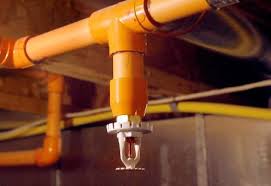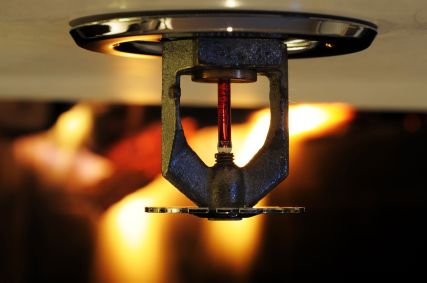Fire sprinkler systems are a great way to keep your structure and the people inside it safe from harm. However, the system requires maintenance to work correctly. Fortunately, a lot of the process is something anyone can handle with just a little instruction. If you need help, though, call an expert immediately.
If your building is outfitted with a sprinkler system, you’re right to feel a bit safer. You can rest easy knowing that, should a fire break out, your system will immediately react to keep everyone safe by containing the outbreak until the fire department arrives. However, this will only happen if you’ve been practicing sound fire sprinkler system maintenance. Systems that aren’t properly maintained may not work as they’re supposed to and that could end up costing you the ultimate price. So let’s take a look at what goes into fire sprinkler system maintenance and then take action to ensure you’re doing what’s necessary.
How Sprinklers Work
First, however, let’s take a quick look at how your fire sprinklers actually work. In the movies, at the first hint of fire, every sprinkler on the building’s floor goes off, covering the entire area in water.
That’s not how it actually works though. Each sprinkler head is designed to only go off when the area around it is hot enough to melt the fusible link blocking the flow of water. So a fire could actually only activate one or two heads, which then work to contain the flames until the authorities make it to the scene.
Why is this important? We’ll elaborate shortly, but the takeaway is that each head needs its own maintenance. It’s not like they all run on a single activation system and if one isn’t working correctly, the others will just pick up the slack.
The Control Valve
Any discussion on fire sprinkler system maintenance needs to touch on the control valve. It’s an essential part of any fire sprinkler system, and also an easy one to inspect. Essentially, there’s a valve in your building that must remain open in order for the water supply to flow. If this valve is off, your sprinklers will get no water and be useless in the case of a fire. Unfortunately, closed valves are the leading cause of widespread fire damage.
The good news is that checking the valve is probably the easiest component of fire sprinkler system maintenance. Just take a look once a week to ensure it’s still locked in the open position.
Also, sometimes the valve needs to be shut off to conduct maintenance or handle repairs on your system. When this is the case, be sure water is only shut off to the one area where the work is being done and only for as long as completely necessary. There’s no reason to take unnecessary risks.
Inspecting Sprinklers
When you want to inspect the actual sprinklers, you need to turn off the valve, as we just mentioned. It’s a good idea to put a brightly colored tag or ribbon on the valve when you do this as a visual reminder to you or anyone else who passes by that the valve needs to be turned back on later.
Also, alert the local authorities that you’re conducting fire sprinkler system maintenance. Your alarm company should know too in case you need to set yours off for a drill or as part of repairs. It’s also not a bad idea to tell your insurance company. Sometimes this is mandatory if it means keeping yourself covered by conducting regular fire sprinkler system maintenance.
Like we already said, keep your inspection to only as many sprinklers as necessary and allow the rest to operate as normal. You also want to make sure that you keep any ignition sources out of the area for the duration of the inspection.
In terms of how often you should conduct maintenance on your sprinklers, check NFPA 25: Standard for the Inspection, Testing, and Maintenance of Water-Based Fire Protection Systems. Depending on your municipality, you may need a certified contractor to handle your inspections and testing for you.
General Understanding
When it comes to your fire sprinkler system maintenance, no matter what rules you’re bound to by local powers and your insurance company, make sure your staff has a general understanding of the system. This should include:
• Where the valve is and what it looks like when it’s open and closed
• What a sprinkler looks like if anything’s wrong
• Ensuring sprinklers are never blocked
Maintaining your fire sprinklers doesn’t need to be demanding, but it does need to get done. The simple steps above could be enough to save lives someday.
Having specialized in the fire sprinkler system maintenance signs trade for over 25 years, USAFP now works tirelessly to promote affordable fire safety for home and for business.
Source: ClicK Here

